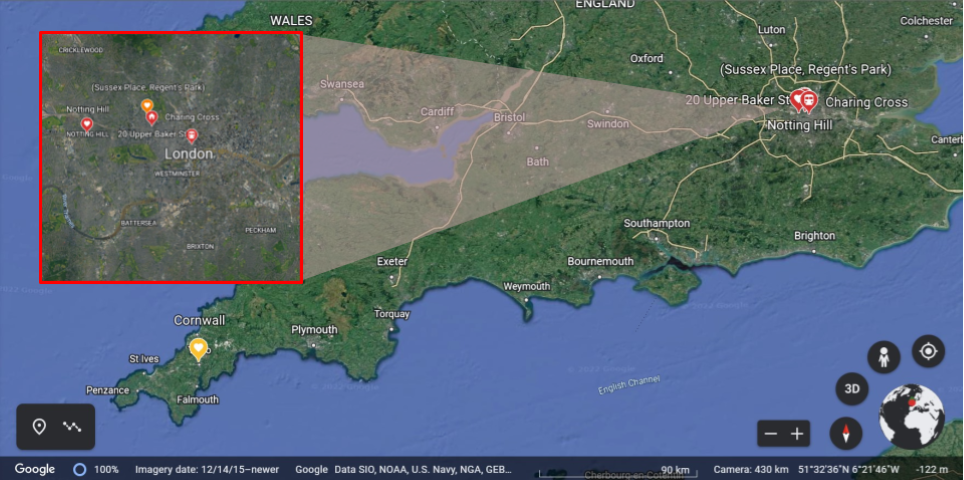Across Baker Street stands Regent’s Park, the second stop of this tour. Those who read The Romance of a Shop (published in 1888) by Amy Levy, may recognize this park as the location of Lord Watergate’s home: Sussex Place. The “white curve of houses with the columns, the cupolas, and the railed-in space of garden which fronted the Park” (Levy) as described by the narrator in chapter five can all be found at the south western portion of Regent’s Park .
Regents Park began with Prince Regent (later known as King George IV of the United Kingdom), who wanted a “new Summer Palace in north London” (royalparks.org). Government architect John Nash redesigned the region once known as Marylebone Park into “a huge circle with a lake, a canal and the new royal residence inside” (royalparks.org), and he renamed it Regent’s Park. Royalparks.org also states that although the original plan included fifty-six villas and a series of terraced buildings, only eight of those villas were built. The summer palace that Prince Regence desired was also never built. Although not all of Nash’s plan was implemented, his design for Regent’s Park was considered one of the first examples of a garden suburb, and it continues to influence the suburb designs in the modern day (royalparks.org).
The park was exclusive to the residents of the villas until 1835, when the east side of the park was first opened to the public. Eventually, the rest of Regent’s Park opened to the public, allowing common folk to visit the park the way that Gertrude and Lucy did in chapter fourteen of The Romance of a Shop - passing through Clarence Gate on their way back from their studio (Levy).
Sussex Place, named after the Duke of Sussex, was one of the terraced buildings designed by John Nash. Featuring a pattern of cupolas - dome structures that form the roof of a building (Oxford English Dictionary) - and Corinthian columns, this row of twenty-six terraced buildings was built in 1883 by William Smith as part of the construction of Regent’s Park Crown Estate (National Heritage List for England). Historian Thomas Allen commented on the design of Sussex Place stating that features like the “silvery sheet” of Boating Lake “that [reflected] the oriental cupolas with full effect” and “varied plantations of the Park, especially on the opposite margin of the lake” gave Sussex Place a powerful appeal in the late nineteenth century (Allen 343). Members of the upper class like Lord Watergate in Levy’s novel would often look to buildings like Sussex Place as potential residence.
Sussex Place still stands in the modern day, albeit with a new name. In the late 1960s, the London School of Business acquired and converted Sussex Place for educational use (London School Businesses). This seems a fitting fate for Lord Watergate’s place of residence in Levy’s novel because Gertrude first met her love interest and future husband on a business venture in chapter five: “to photograph a dead person”. That interaction bloomed the development of genuine affection - a meeting of minds.
Works Cited
“1 To 26 Sussex Place London Graduate School of Business Studies, Non Civil Parish - 1264092: Historic England.” National Heritage List for England. https://historicengland.org.uk/listing/the-list/list-entry/1264092?sect…. Accessed 22 Sep. 2022.
Allen, Thomas. The History and Antiquities of London, Westminster, Southwark, and parts adjacent. George Virtue 26 Ivy lane Paternoster Row, 1836, vol. 5, p. 343.
“Cupola” Oxford English Dictionary, Oxford University Press, 2022, https://www.oed.com/view/Entry/45903?isAdvanced=false&result=1&rskey=Jd…;. Accessed 22 Sep. 2022.
Google Earth, Google, https://earth.google.com/web/.
“Landscape History.” The Royal Parks, https://www.royalparks.org.uk/parks/the-regents-park/about-regents-park…. Accessed 22 Sep. 2022.
Levy, Amy. The Romance of a Shop. The Algonquin Press, 1889
"Metropolitan Improvements ... From original drawings by T. H. Shepherd, etc". (2013). flickr.com. Retrieved September 19, 2022, from https://www.flickr.com/photos/12403504@N02/11007937583.
“Our Campuses.” London Business School. https://www.london.edu/about/our-campuses/london. Accessed 22 Sep. 2022.
Stern, Robert A.M., et al. Paradise Planned: The Garden Suburb and the Modern City. The Monacelli Press, 2013. p. 23. ISBN 978-1580933261.



